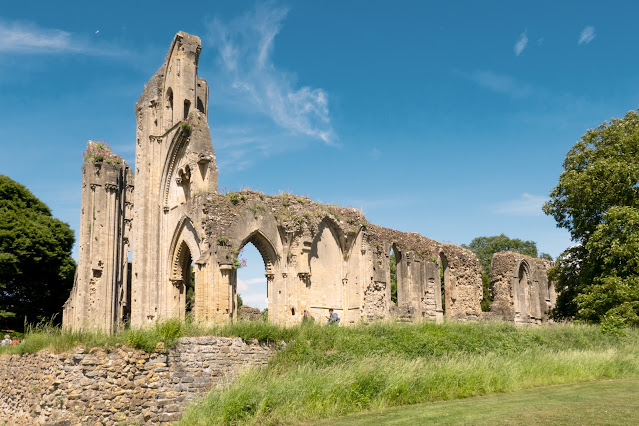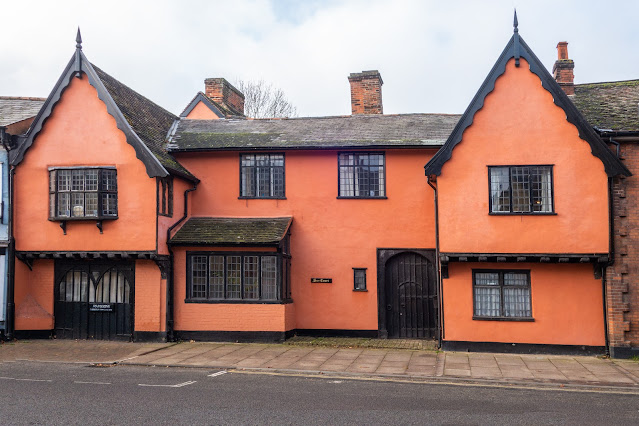When the town of Glastonbury crops up in a conversation then the first thing that springs to mind is the famous music festival. However, there are other intersting things about the area - one being the TOR.
Having now been into the town, one has to ask "is it held actually in Glastonury?" and the answer is "No, the Glastonbury Festival is not actually in the town of Glastonbury. It's held on Worthy Farm in Pilton, a village about 7 miles (13 km) east of Glastonbury"

However, our daughter wanted to see and climb the Tor, which is what we did. She has been to the festival with her brother many moons ago!
Here are my daughter, wife and grandaughter posing at the bottom of the Tor, poised and ready to go.
Daughter and grandaughter, part way up, looking down to the start.
.... and the town of Glatonbury when we were part way up.
We had a good climb to the top and all enjoyed it. After a walk around the Tor we headed down. The 13th-century tower which forms a landmark on the summit of Glastonbury Tor, is all that remains of St Michael's Church. The original wooden church was destroyed by an earthquake in 1275, and the stone Church of St Michael was built on the site in the 14th century. Its tower remains, although it has been restored and partially rebuilt several times.
I was rather attracted to this image of the person sitting amongst the yellow flowers enjoying a drink. Taken at the bottom of the Tor.
Glastonbury is often described as a "superstitious" or "mystical" town, and for good reason. Its long history, rich in myth and legend, has contributed to its reputation as a spiritual hub and a place where mystical energies are believed to be strong. Glastonbury being home to Glastonbury Tor, which is believed to have been a site of Celtic pagan worship before Christianity and now a popular destination for spiritual seekers. The town also contains the Chalice Well, another site of historical and spiritual significance, with legends suggesting it is linked to the Holy Grail - another legend in itself!
The town is intertwined with both Arthurian legends (including the story of King Arthur's burial) and the early history of Christianity in England, and has a thriving counterculture and New Age community, with many independent shops and businesses reflecting this interest in spiritual practices and alternative beliefs.
Glastonbury also has a long tradition of being 'The Isle of Avalon' where King Arthur went after his last battle. The monks of Glastonbury Abbey claimed to have found his grave in 1191. The unfortunate thing is of course that no historical records exist from that time and the earliest mention of him was by a well known Catholic Cleric Geoffrey of Monmouth who supposedly copied details from earlier documents in the 12th century. Also no modern historian or researcher can find any positive indication that he even existed!
Even Jesus is said to have come to Glastonbury as a boy, travelling here with Joseph of Arimathea. Another realy bizzare claim. Glastonbury was part of the Celtic Kingdom of the Dumnonii at the time, the Romans invading later. Why on earth would they have come to the ancient land of the Celts from Israel? And of course `how?` - as most travelling by people was on a donkey! Also, there is no hint in the Gospels of the two knowing each other when Jesus was young.
Bottom line: All this of course really attracts the tourists!
While the family wandered the town, Rosey and I headed for the ruined abbey.
One of the building we passed on the way was obviously where they used to collect Tolls from passing trade. Here is an explantion I found about turnpikes:
`They originated in the 17th century because local governments, specifically parishes, were unwilling or unable to invest in roads. The finances of turnpike trusts were distinctive because they levied tolls on road users and issued bonds mortgaged on these tolls. Also, they were locally managed and financed.`
And so onto the Abbey`s spectacular ruin.
The earliest historical evidence for the monastery at Glastonbury, including land grants and privileges, appears in the last 30 years of the 7th century. By the time of the coming of the Normans, the abbey was the wealthiest in England and its wealth only grew up until the Dissolution of the Monasteries in the 16th century.
It was the second longest church in Britain at the time, with a total internal length of about 176m (580ft). Fountains Abbey being the largest.
The Lady Chapel is apparently one of the finest late 12th century monuments in Britain.


Bearing in mind the overall sceptisim around King Arthur, one wonders who was really buried here?
We didn`t go in this building but its the Abbot's Kitchen. This kitchen is situated to the south of the Abbey church ruins. It is one of the best preserved Medieval kitchens in Europe and the only substantial monastic building at Glastonbury. It was built in the 14th century.

















Comments